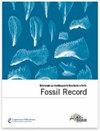Thomas A. Neubauer, Oleg Mandic, Mathias Harzhauser
下载PDF
{"title":"The Middle Miocene freshwater mollusk fauna of Lake Gacko (SE Bosnia and Herzegovina): taxonomic revision and paleoenvironmental analysis","authors":"Thomas A. Neubauer, Oleg Mandic, Mathias Harzhauser","doi":"10.1002/mmng.201300003","DOIUrl":null,"url":null,"abstract":"<p>The early Middle Miocene Lake Gacko was part of the Dinaride Lake System (DLS) and gave rise to a poorly known freshwater mollusk fauna. This was subject to malacological studies from the late 19th century onwards. Herein, we provide the first thorough taxonomic survey of Lake Gacko including revisions of several taxa. A total amount of 1,077 specimens was obtained from 17 samples, comprising at least 11 freshwater and 2 terrestrial gastropod species and 6 bivalve species. So far, none of the described taxa has been documented outside the Dinarides and the DLS, respectively. The fauna shows variable overlap with other paleolakes of the DLS, proofing once more the complex biogeographic patchwork of this system. The current paleoenvironmental reconstructions are tested and refined by application of a statistical analysis. This confirms the partition of the sedimentary history of Lake Gacko into three major depositional phases responding to astronomically forced climate changes. The low diverse mollusk assemblage in the initial phase, with abundant pulmonate and rissooid gastropods, signals a more arid climate with lowered lake level. During the second interval, the fauna becomes more diverse with common rissooid and melanopsid gastropods. It represents a more humid interval with enhanced precipitation and increased lake level, entailing the installation of a perennial lacustrine environment. The final phase is a return to arid conditions with the same elements as in the initial pulmonate-rissooid assemblage. The sphaeriid <i>Pisidium vukovici</i> n. sp. is introduced as new species. (© 2013 WILEY-VCH Verlag GmbH & Co. KGaA, Weinheim)</p>","PeriodicalId":55147,"journal":{"name":"Fossil Record","volume":"16 1","pages":"77-96"},"PeriodicalIF":2.1000,"publicationDate":"2013-02-21","publicationTypes":"Journal Article","fieldsOfStudy":null,"isOpenAccess":false,"openAccessPdf":"https://sci-hub-pdf.com/10.1002/mmng.201300003","citationCount":"20","resultStr":null,"platform":"Semanticscholar","paperid":null,"PeriodicalName":"Fossil Record","FirstCategoryId":"89","ListUrlMain":"https://onlinelibrary.wiley.com/doi/10.1002/mmng.201300003","RegionNum":4,"RegionCategory":"地球科学","ArticlePicture":[],"TitleCN":null,"AbstractTextCN":null,"PMCID":null,"EPubDate":"","PubModel":"","JCR":"Q3","JCRName":"Earth and Planetary Sciences","Score":null,"Total":0}
引用次数: 20
引用
批量引用
Abstract
The early Middle Miocene Lake Gacko was part of the Dinaride Lake System (DLS) and gave rise to a poorly known freshwater mollusk fauna. This was subject to malacological studies from the late 19th century onwards. Herein, we provide the first thorough taxonomic survey of Lake Gacko including revisions of several taxa. A total amount of 1,077 specimens was obtained from 17 samples, comprising at least 11 freshwater and 2 terrestrial gastropod species and 6 bivalve species. So far, none of the described taxa has been documented outside the Dinarides and the DLS, respectively. The fauna shows variable overlap with other paleolakes of the DLS, proofing once more the complex biogeographic patchwork of this system. The current paleoenvironmental reconstructions are tested and refined by application of a statistical analysis. This confirms the partition of the sedimentary history of Lake Gacko into three major depositional phases responding to astronomically forced climate changes. The low diverse mollusk assemblage in the initial phase, with abundant pulmonate and rissooid gastropods, signals a more arid climate with lowered lake level. During the second interval, the fauna becomes more diverse with common rissooid and melanopsid gastropods. It represents a more humid interval with enhanced precipitation and increased lake level, entailing the installation of a perennial lacustrine environment. The final phase is a return to arid conditions with the same elements as in the initial pulmonate-rissooid assemblage. The sphaeriid Pisidium vukovici n. sp. is introduced as new species. (© 2013 WILEY-VCH Verlag GmbH & Co. KGaA, Weinheim)
波黑东南部加科湖中新世淡水软体动物区系:分类修正与古环境分析
中新世早期的Gacko湖是Dinaride湖系统(DLS)的一部分,并产生了一种鲜为人知的淡水软体动物群。从19世纪后期开始,这就成为了线虫学研究的主题。本文首次对加科湖进行了全面的分类调查,包括对几个分类群的修订。共采集标本1077份,其中淡水腹足类11种,陆生腹足类2种,双壳类6种。到目前为止,除了Dinarides和DLS之外,没有任何被描述的分类群被记录在案。动物群与DLS的其他古湖泊表现出不同程度的重叠,再次证明了该系统复杂的生物地理拼凑。用统计分析的方法对现有的古环境重建结果进行了检验和改进。这证实了Gacko湖的沉积历史划分为三个主要的沉积阶段,以响应天文强迫的气候变化。在初始阶段,软体动物的多样性较低,有大量的肺状和rissooid腹足类动物,这表明气候更加干旱,湖泊水位降低。在第二个间歇期,动物群变得更加多样化,有常见的穗状纲和黑足纲腹足类。它代表了一个更湿润的区间,降水增加,湖泊水位上升,需要建立一个多年生湖泊环境。最后一个阶段是回归到干旱的条件,具有与最初的肺-rissooid组合相同的元素。球虫Pisidium vukovici n. sp.作为新种引种。(©2013 WILEY-VCH Verlag GmbH &KGaA公司,Weinheim)
本文章由计算机程序翻译,如有差异,请以英文原文为准。

 求助内容:
求助内容: 应助结果提醒方式:
应助结果提醒方式:


